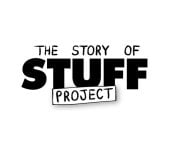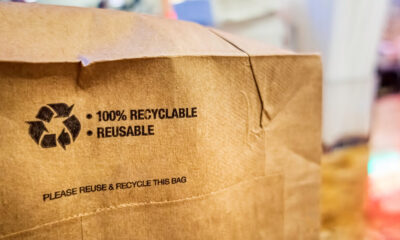

Features
Behind The Story of Stuff – Part II
Blue & Green Tomorrow is passionate about reducing the impact that we consumers have on our finite blue and green planet. We are, therefore, delighted to share the second part of an interview with Annie Leonard on her motivations and the future of The Story of Stuff Project.
Blue & Green Tomorrow is passionate about reducing the impact that we consumers have on our finite blue and green planet. We are, therefore, delighted to share the second part of an interview with Annie Leonard on her motivations and the future of The Story of Stuff Project.
Missed part one? Catch up here.
What motivates you in your endless pursuit for a society free from the ills of waste and consumerism?
I had the amazing good fortune to visit over 40 countries in the course of my activist career. I have visited Central America, Western and Eastern Europe, Southern Africa, the Caribbean and Asia. For three years, I lived in South Asia. I met workers and activists and community residents. I attended conferences and strategy meetings. I visited infamous sites like Bhopal, India, the site of the largest chemical industrial disaster in history and Gonaives, Haiti, where ash from a U.S. municipal waste incinerator was disguised as fertiliser and dumped on a beach.
I think the most inspiring thing I saw was the many positive examples of people organising their homes, their economies and their politics in different ways. When we grow up in one society, we can too often mistake the dominant way as the best or only way. So it is tremendously illuminating to get out and to see how others live. I’ve seen a wide range of government policies, innovative land use planning, respect for the commons, restrictions on the commercialisation of culture that have led to very different results compared with the toxics-laden, consumer-driven model we currently have in the US. It shows me over and over that we could do things differently. It is not set in stone that we have to trash the planet and endure massive social inequality; these realities are the results of specific choices made by government and business leaders over time. And we can make different choices – choices that better serve the planet and its many communities.
Of course, being a parent is a tremendous motivation. Like all parents, I want the best for my kid, so I’ve become more vigilant about the products I bring into my home. I used resources like Goodguide.com and the Skin Deep database to screen products to avoid those containing toxic chemicals when possible.
Parenting has also inspired me to be a better activist. Before having a kid, I’d work late into the night and many weekends without hesitation; I cared about the issues, enjoyed the company of my colleagues and it was fun! Now, I actually have something I’d rather do in my off hours so I have learned to focus more when I am doing my work so that I have time to turn off the computer and play with my daughter.
What do you hope to achieve with the work from the Story of Stuff? What do you want to change?
As I said earlier, I want to help people move from being passive consumers to active citizens. And I don’t just mean that I want them to make changes in their own lives. The biggest environmental myth I’d like to quash is that the challenges facing the planet today can be overcome through changes at an individual lifestyle level. Yes, of course, it is helpful and responsible and good to conserve energy at home, to ride a bike instead of drive, to carry a cloth bag to the store, even to buy the least toxic and least exploitive products available. We should live our lives as responsibly as possible but it is a mistake to focus all of our attention at that level. We simply must get involved with organisations working for broader systemic change.
What has been the reaction to The Story of Stuff Project?
I never dreamed that a 20-minute cartoon would resonate with so many people in such a deep way. I was blown away by the response to the first film, and quickly realised that we didn’t just have an audience but a community – hundreds of thousands of people all over the world who look to The Story of Stuff Project not just for information but as a vehicle to connect to others who are striving to live a less Stuff-centered life. The wide use of the film by schools and faith communities has been especially gratifying. And our community is worldwide – something like 40 percent of the people who visit our website come from outside the United States. We have had a relatively small number of people, mostly in the right-wing media, accuse us of being anti-American or anti-capitalist, but we try to stay focused on connecting more deeply with the people who do embrace our message.
How do you do your research? How do you ensure the research is thorough and accurate?
The material in the first film came from my lifetime obsession with Stuff. One of the things we’re proudest of is that for each of the subsequent films we’ve partnered with activist organisations who are conducting ongoing campaigns on those issues, such as the Safe Cosmetics Campaign or the Electronics TakeBack Coalition. They help us make sure that everything we say in the film is carefully researched and referenced – that’s why each film includes onscreen facts and an annotated script with additional detail. The industries and interest groups we take on in the films have often criticised our interpretation of the facts, but the facts themselves stand up.
Why do you use the illustration style of presentation?
The first film is based on a live talk that I gave for years at schools, conferences – all kinds of events. In the live talk, I have a large sheet of butcher paper on a wall behind me and I walk people through the Story of Stuff, drawing as I go. Every time I gave the talk, someone would ask for a movie of it. For three years, I delayed, thinking no one would watch a movie of me talking about systems of production and consumption. When I just got so sick of doing the talk, I finally made a movie. I had a friend film me doing the live talk one last time, then went to Free Range Studios to ask them how one might capture the presentation online.
Jonah Sachs and Louis Fox, who co-founded Free Range Studios, and Free Range’s animation director, Ruben DeLuna, deserve all the credit. They created a style that is so inviting and refreshing that they balance out the severity and grimness of the actual data. The environmental situation is scary and the cute drawings offered a little relief, which allowed us to explore the topic even further. I am guessing that if we had used real footage of trashed eco systems, poisoned workers and toxic waste, far fewer people would have sat through the whole 20 minutes.
The number one complaint I get about the film is that I left something out, to which I say “duh, it’s a 20 minute cartoon.” Yes, I left stuff out. Yes, I oversimplified. You can’t fit everything in an entire global system in 20 minutes. That said there is a difference between dumbing down and simplifying. I did simplify; I did not dumb down. I said it like it is. That’s our challenge – how to distill down complex, often technical, sometimes boring and wonky issues in a way that is accessible but doesn’t dumb it down.
How long does it take, including research, to complete one of your films?
We’ve done three films a year in the past two years, so it averages out to about four months of solid work on each one. But we don’t start from scratch each time. There’s a lot of thinking ahead, one or two films down the road.
Do you think that it is important to create a sustainable economy for the benefit of the environment and its people?
Sure. But we’ve got to be clear about what ‘sustainable’ means. Our economy is built around a deep belief that unlimited economic growth is both desirable and possible. The data doesn’t back this up. Once a country gets to a certain point in its industrial development (e.g., safe houses, secure food, access to medicine), increased economic growth does not necessarily add to happiness and well-being, and in many cases can undermine these things. Unfortunately, our political and economic leaders got off track in this country thinking that economic growth is the goal, and are willing to sacrifice good schools, a clean environment and public health for these things. It should be the other way around: health and happiness should be the goal with economic growth one tool among many.
What has been your personal highlight of The Story of Stuff Project so far?
Every day I get emails and letters from people and, when I am traveling about, I meet people who say that The Story of Stuff Project’s films have inspired them to rethink their relationship with stuff and to get involved in making the world better. There’s nothing that makes me happier than hearing these stories from kids, business people, educators, faith leaders, parents, economists – all kinds of people. I am enormously grateful to them for feeding my sense of hope.
What is the future lies ahead for The Story of Stuff?
We’re always looking at new media platforms that will give us an opportunity to reach more people. But what we’re really excited about is deepening our relationship with our community. If people in our community connect with each other and start local projects that are not affiliated with The Story of Stuff, that’s fine. We don’t need to perpetuate the organisation. Let a thousand flowers bloom.






























